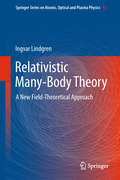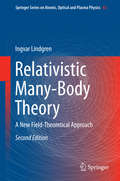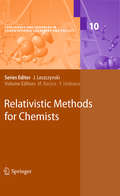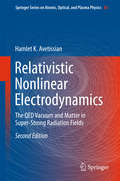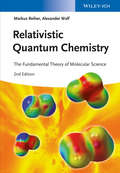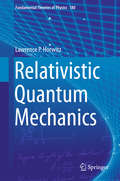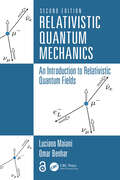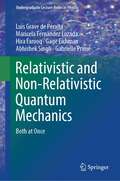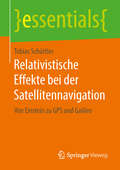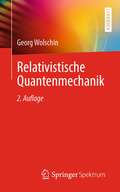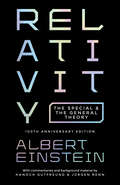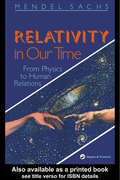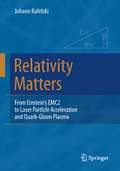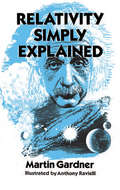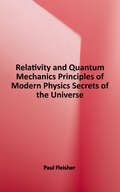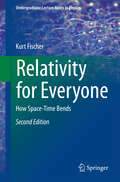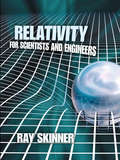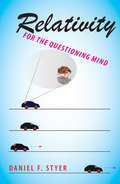- Table View
- List View
Relativistic Many-Body Theory
by Ingvar LindgrenRelativistic Many-Body Theory treats — for the first time — the combination of relativistic atomic many-body theory with quantum-electrodynamics (QED) in a unified manner. This book can be regarded as a continuation of the book by Lindgren and Morrison, Atomic Many-Body Theory (Springer 1986), which deals with the non-relativistic theory of many-electron systems, describing several means of treating the electron correlation to essentially all orders of perturbation theory. The treatment of the present book is based upon quantum-field theory, and demonstrates that when the procedure is carried to all orders of perturbation theory, two-particle systems are fully compatible with the relativistically covariant Bethe-Salpeter equation. This procedure can be applied to arbitrary open-shell systems, in analogy with the standard many-body theory, and it is also applicable to systems with more than two particles. Presently existing theoretical procedures for treating atomic systems are, in several cases, insufficient to explain the accurate experimental data recently obtained, particularly for highly charged ions. This shortcoming is expected to be due to omission of combined QED-correlational effects, included in the new unified procedure.<P><P> All methods treated in Relativistic Many-Body Theory are illustrated with numerical examples. The main text is divided into three parts.<P><P> In Part I, the standard time-independent and time-dependent perturbation procedures are reviewed.<P> Part II describes three methods for QED calculations, a) the standard S-matrix formulation, b) the Two-times Green’s-function method, developed by the St Petersburg Atomic Theory group, and c) the Covariant-evolution-operator (CEO) method, recently developed by the Gothenburg Atomic Theory group.<P> In Part III, the CEO method is combined with electron correlation to arbitrary order to a unified MBPT-QED procedure. In this procedure the electron correlation can be included to high order, and therefore this procedure is expected to lead to faster convergence than treating the BS equation order by order.<P> Ingvar Lindgren is also the author of the highly-cited "Atomic Many-Body Theory" book published by Springer.
Relativistic Many-Body Theory, 2nd Edition
by Ingvar LindgrenThis revised second edition of the author’s classic text offers readers a comprehensively updated review of relativistic atomic many-body theory, covering the many developments in the field since the publication of the original title. In particular, a new final section extends the scope to cover the evaluation of QED effects for dynamical processes.<P><P> The treatment of the book is based upon quantum-field theory, and demonstrates that when the procedure is carried to all orders of perturbation theory, two-particle systems are fully compatible with the relativistically covariant Bethe-Salpeter equation. This procedure can be applied to arbitrary open-shell systems, in analogy with the standard many-body theory, and it is also applicable to systems with more than two particles. Presently existing theoretical procedures for treating atomic systems are, in several cases, insufficient to explain the accurate experimental data recently obtained, particularly for highly charged ions.<P> The main text is divided into three parts. In Part I, the standard time-independent and time-dependent perturbation procedures are reviewed. This includes a new section at the end of chapter 2 concerning the so-called ”Fock-space procedure” or ”Coulomb-only procedure” for relativistic-QED calculations. This is a procedure on an intermediate level, frequently used in recent time by chemists on molecular systems, where a full QED treatment is out of question. Part II describes three methods for QED calculations, a) the standard S-matrix formulation, b) the Two-times Green’s-function method, developed by the St Petersburg Atomic Theory group, and c) the Covariant-evolution operator (CEO) method, recently developed by the Gothenburg Atomic Theory group. In Part III, the CEO method is combined with electron correlation to arbitrary order to a unified MBPT-QED procedure. The new Part IV includes two new chapters dealing with dynamical properties and how QED effects can be evaluated for such processes. This part is much needed as there has been an increasing interest in the study of QED effects for such processes.<P> All methods treated in the book are illustrated with numerical examples, making it a text suitable for advanced students new to the field and a useful reference for established researchers.
Relativistic Methods for Chemists
by Yasuyuki Ishikawa Maria Barysz"Relativistic Methods for Chemists", written by a highly qualified team of authors, is targeted at both experimentalists and theoreticians interested in the area of relativistic effects in atomic and molecular systems and processes and in their consequences for the interpretation of the heavy element's chemistry. The theoretical part of the book focuses on the relativistic methods for molecular calculations discussing relativistic two-component theory, density functional theory, pseudopotentials and correlations. The experimentally oriented chapters describe the use of relativistic methods in different applications focusing on the design of new materials based on heavy element compounds, the role of the spin-orbit coupling in photochemistry and photobiology, and chirality and its relations to relativistic description of matter and radiation. This book is written at an intermediate level in order to appeal to a broader audience than just experts working in the field of relativistic theory.
Relativistic Nonlinear Electrodynamics
by Hamlet K. AvetissianThis revised edition of the author's classic 2006 text offers a comprehensively updated review of the field of relativistic nonlinear electrodynamics. It explores the interaction of strong and super-strong electromagnetic/laser radiation with the electromagnetic quantum vacuum and diverse types of matter - including free charged particles and antiparticles, acceleration beams, plasma and plasmous media. The appearance of laser sources of relativistic and ultra-relativistic intensities over the last decade has stimulated investigation of a large class of processes under such super-strong radiation fields. Revisions for this second edition reflect these developments and the book includes new chapters on Bremsstrahlung and nonlinear absorption of superintense radiation in plasmas, the nonlinear interaction of relativistic atoms with intense laser radiation, nonlinear interaction of strong laser radiation with Graphene, and relativistic nonlinear phenomena in solid-plasma targets under supershort laser pulses of ultrarelativistic intensities. The only book devoted to the subject of relativistic nonlinear electrodynamics, this second edition will be a valuable resource for graduate students and researchers involved in any aspect of the field, including those working with intense x-ray - gamma-ray lasers, the new generation of small size laser-plasma accelerators of superhigh energies and high-brightness particle beams.
Relativistic Quantum Chemistry
by Markus Reiher Alexander WolfEinstein proposed his theory of special relativity in 1905. For a long time it was believed that this theory has no significant impact on chemistry. This view changed in the 1970s when it was realized that (nonrelativistic) Schrödinger quantum mechanics yields results on molecular properties that depart significantly from experimental results. Especially when heavy elements are involved, these quantitative deviations can be so large that qualitative chemical reasoning and understanding is affected. For this to grasp the appropriate many-electron theory has rapidly evolved. Nowadays relativistic approaches are routinely implemented and applied in standard quantum chemical software packages. As it is essential for chemists and physicists to understand relativistic effects in molecules, the first edition of 'Relativistic Quantum Chemistry - The fundamental Theory of Molecular Science' had set out to provide a concise, comprehensive, and complete presentation of this theory.The second edition of Relativistic Quantum Chemistry: The Fundamental Theory of Molecular Science expands on some of the latest developments in this fascinating field. The text retains its clear and consistent style, allowing for a readily accessible overview of the complex topic. It is also self-contained, building on the fundamental equations and providing the mathematical background necessary. While some parts of the text have been restructured for the sake of clarity a significant amount of new content has also been added. This includes, for example, an in-depth discussion of the Brown-Ravenhall disease, of spin in current-density functional theory, and of exact two-component methods and its local variants.A strength of the first edition of this textbook was its list of almost 1000 references to the original research literature, which has made it a valuable reference also for experts in the field. In the second edition, more than 100 additional key references have been added - most of them considering the recent developments in the field.Thus, the book is a must-have for everyone entering the field, as well as for experienced researchers searching for a consistent review.
Relativistic Quantum Invariance (Lecture Notes in Physics #1012)
by Chueng-Ryong JiThis book describes the invariant nature of the relativistic quantum field theories utilizing the idea of interpolating the instant form dynamics and the light-front dynamics. While the light-front dynamics (LFD) based on the light-front time was proposed by Dirac in 1949, there has not yet been a salient review on the connection between the LFD and the instant form dynamics (IFD) based on the ordinary time. By reviewing the connection between LFD and IFD using the idea of interpolating the two different forms of the relativistic dynamics, one can learn the distinguished features of each form and how one may utilize those distinguished features in solving the complicated relativistic quantum field theoretic problems more effectively. With the ongoing 12-GeV Jefferson Lab experiments, the internal structures of the nucleon and nuclei are vigorously investigated in particular using the physical observables defined in the LFD rather than in the IFD. This book offers a clear demonstration on why and how the LFD is more advantageous than the IFD for the study of hadron physics, illustrating the differences and similarities between these two distinguished forms of the dynamics. It aims at presenting the basic first-hand knowledge of the relativistic quantum field theories, describing why and how the different forms of dynamics (e.g., IFD and LFD) can emerge in them, connecting the IFD and the LFD using the idea of the interpolation, and demonstrating explicit examples of the interpolation in quantum electrodynamics and other field theories. While the level of presentation is planned mainly for the advanced undergraduate students and the beginning graduate students, the topics of the interpolation between the IFD and the LFD are innovative enough for even the experts in the field to appreciate its usefulness.
Relativistic Quantum Mechanics
by Lawrence P. HorwitzThis book describes a relativistic quantum theory developed by the author starting from the E. C. G. Stueckelberg approach proposed in the early 40s. In this framework a universal invariant evolution parameter (corresponding to the time originally postulated by Newton) is introduced to describe dynamical evolution. This theory is able to provide solutions for some of the fundamental problems encountered in early attempts to construct a relativistic quantum theory. A relativistically covariant construction is given for which particle spins and angular momenta can be combined through the usual rotation group Clebsch-Gordan coefficients. Solutions are defined for both the classical and quantum two body bound state and scattering problems. The recently developed quantum Lax-Phillips theory of semi group evolution of resonant states is described. The experiment of Lindner and coworkers on interference in time is discussed showing how the property of coherence in time provides a simple understanding of the results. The full gauge invariance of the Stueckelberg-Schroedinger equation results in a 5D generalization of the usual gauge theories. A description of this structure and some of its consequences for both Abelian and non-Abelian fields are discussed. A review of the basic foundations of relativistic classical and quantum statistical mechanics is also given. The Bekenstein-Sanders construction for imbedding Milgrom's theory of modified spacetime structure into general relativity as an alternative to dark matter is also studied.
Relativistic Quantum Mechanics (Fundamental Theories of Physics #180)
by Lawrence P. HorwitzThis book describes a relativistic quantum theory developed by the author starting from the E.C.G. Stueckelberg approach proposed in the early 40s. In this framework a universal invariant evolution parameter (corresponding to the time originally postulated by Newton) is introduced to describe dynamical evolution. This theory is able to provide solutions for some of the fundamental problems encountered in early attempts to construct a relativistic quantum theory. A relativistically covariant construction is given for which particle spins and angular momenta can be combined through the usual rotation group Clebsch-Gordan coefficients. Solutions are defined for both the classical and quantum two body bound state and scattering problems. The recently developed quantum Lax-Phillips theory of semi group evolution of resonant states is described. The experiment of Lindner and coworkers on interference in time is discussed showing how the property of coherence in time provides a simple understanding of the results. The full gauge invariance of the Stueckelberg-Schroedinger equation results in a 5D generalization of the usual gauge theories. A description of this structure and some of its consequences for both Abelian and non-Abelian fields are discussed. A review of the basic foundations of relativistic classical and quantum statistical mechanics is also given. The Bekenstein-Sanders construction for imbedding Milgrom's theory of modified spacetime structure into general relativity as an alternative to dark matter is also studied.
Relativistic Quantum Mechanics: An Introduction to Relativistic Quantum Fields
by Luciano Maiani Omar BenharWritten by two of the most prominent leaders in particle physics, Relativistic Quantum Mechanics: An Introduction to Relativistic Quantum Fields provides a classroom-tested introduction to the formal and conceptual foundations of quantum field theory. Designed for advanced undergraduate- and graduate-level physics students, the text only requires previous courses in classical mechanics, relativity, and quantum mechanics.The introductory chapters of the book summarise the theory of special relativity and its application to the classical description of the motion of a free particle and a field. The authors then explain the quantum formulation of field theory through the simple example of a scalar field described by the Klein–Gordon equation as well as its extension to the case of spin ½ particles described by the Dirac equation. They also present the elements necessary for constructing the foundational theories of the standard model of electroweak interactions, namely quantum electrodynamics and the Fermi theory of neutron beta decay. Many applications to quantum electrodynamics and weak interaction processes are thoroughly analysed. The book also explores the timely topic of neutrino oscillations.Logically progressing from the fundamentals to recent discoveries, this textbook provides students with the essential foundation to study more advanced theoretical physics and elementary particle physics. It will help them understand the theory of electroweak interactions and gauge theories.View the second and third books in this collection: Electroweak Interactions and An Introduction to Gauge Theories.Key Features of the new edition:Besides a general revision of text and formulae, three new chapters have been added.· Chapter 17 introduces and discusses double beta decay processes with and without neutrino emission, the latter being the only process able to determine the Dirac or Majorana nature of the neutrino (discussed in Chapter 13). A discussion of the limits to the Majorana neutrino mass obtained recently in several underground laboratories is included.· Chapter 18 illustrates the calculation of the mass spectrum of “quarkonia” (mesons composed by a pair of heavy, charm or beauty quarks), in analogy with the positronium spectrum discussed in Chapter 12. This calculation has put into evidence the existence of “unexpected” states and has led to the new field of “exotic hadrons”, presently under active theoretical and experimental scrutiny.· Chapter 19 illustrates the Born-Oppenheimer approximation, extensively used in the computation of simple molecules, and its application to the physics of exotic hadrons containing a pair of heavy quarks, with application to the recently observed doubly charmed baryons.This eBook was published Open Access with funding support from the Sponsoring Consortium for Open Access Publishing in Particle Physics (SCOAP3).A PDF version of this book is available for free in Open Access at www.taylorfrancis.com. It has been made available under a Creative Commons Attribution-Non Commercial-No Derivatives 4.0 license.
Relativistic Quantum Physics
by Tommy OhlssonQuantum physics and special relativity theory were two of the greatest breakthroughs in physics during the twentieth century and contributed to paradigm shifts in physics. This book combines these two discoveries to provide a complete description of the fundamentals of relativistic quantum physics, guiding the reader effortlessly from relativistic quantum mechanics to basic quantum field theory. The book gives a thorough and detailed treatment of the subject, beginning with the classification of particles, the Klein-Gordon equation and the Dirac equation. It then moves on to the canonical quantization procedure of the Klein-Gordon, Dirac and electromagnetic fields. Classical Yang-Mills theory, the LSZ formalism, perturbation theory, elementary processes in QED are introduced, and regularization, renormalization and radiative corrections are explored. With exercises scattered through the text and problems at the end of most chapters, the book is ideal for advanced undergraduate and graduate students in theoretical physics.
Relativistic and Non-Relativistic Quantum Mechanics: Both at Once (Undergraduate Lecture Notes in Physics)
by Abhishek Singh Luis Grave de Peralta Maricela Fernández Lozada Hira Farooq Gage Eichman Gabrielle PrimeCurrently, relativistic quantum mechanics is considered an advanced topic only accessible to students who have already received considerable training in non-relativistic quantum mechanics. However, the authors believe that they have found an excellent pedagogic approach for simultaneously introducing both topics. This book is considered an Introductory Quantum Mechanics textbook that presents relativistic quantum mechanics to interested learners with no previous knowledge of it. The authors avoid utilization of the well-known Lorentz invariant equations. Additionally, they only refer to the Klein-Gordon and Dirac equations to justify the use of the Poveda-Poirier-Grave de Peralta (PPGP) equations, upon which this book is solely based (while sporadically referring to well-known results obtained using the Klein-Gordon and Dirac equations to avoid unnecessary complications in an introductory book). There also exist two complementary Schrödinger-like and Pauli-like PPGP equations, the solutions of which are identical to the respective solutions of the Klein-Gordon and Dirac equations associated with negative kinetic energies. These equations’ relation to the existence of antiparticles is discussed. The intended readership is undergraduate physics, chemistry, and engineering students with no previous knowledge of quantum mechanics, as well as graduate students and professionals interested in the subject.
Relativistically Intense Laser–Microplasma Interactions (Springer Theses)
by Tobias OstermayrThis dissertation covers several important aspects of relativistically intense laser–microplasma interactions and some potential applications. A Paul-trap based target system was developed to provide fully isolated, well defined and well positioned micro-sphere-targets for experiments with focused peta-watt laser pulses. The laser interaction turned such targets into microplasmas, emitting proton beams with kinetic energies exceeding 10 MeV. The proton beam kinetic energy spectrum and spatial distribution were tuned by variation of the acceleration mechanism, reaching from broadly distributed spectra in relatively cold plasma expansions to spectra with relative energy spread as small as 20% in spherical multi-species Coulomb explosions and in directed acceleration processes. Numerical simulations and analytical calculations support these experimental findings and show how microplasmas may be used to engineer laser-driven proton sources. In a second effort, tungsten micro-needle-targets were used at a peta-watt laser to produce few-keV x-rays and 10-MeV-level proton beams simultaneously, both measured to have only few-µm effective source-size. This source was used to demonstrate single-shot simultaneous radiographic imaging with x-rays and protons of biological and technological samples. Finally, the dissertation discusses future perspectives and directions for laser–microplasma interactions including non-spherical target shapes, as well as thoughts on experimental techniques and advanced quantitative image evaluation for the laser driven radiography.
Relativistische Effekte bei der Satellitennavigation: Von Einstein zu GPS und Galileo (essentials)
by Tobias SchüttlerTobias Schüttler stellt in diesem essential beide im Detail sehr anspruchsvollen Gebiete – Einsteins berühmte Relativitätstheorie und die Satellitenortung mit GPS und Galileo – in allgemein verständlicher Weise dar und erklärt die Einflüsse der Relativitätstheorie bei der Satellitennavigation ohne höhere Mathematik. Es werden auch die zu dieser Betrachtung wichtigen Formeln genannt und motiviert. Um die Einflüsse der Relativitätstheorie auf ein Satellitennavigationssystem wie das europäische Galileo zu verstehen, muss man sich mit dem konkreten Messvorgang bei der Ortung auseinandersetzen. Die Grundidee des Verfahrens ist einfach – die technische Umsetzung indes höchst komplex.
Relativistische Quantenmechanik
by Georg WolschinDieses Buch richtet sich an Studierende der Physik, die bereits über Grundkenntnisse der Quantenmechanik verfügen und relativistische Wellengleichungen kennenlernen möchten. Im Hauptteil des Buchs behandelt der Autor die Klein-Gordon-Gleichung und die Dirac-Gleichung, wobei er deren Lösungen und ihre Bedeutung hervorhebt. Die Invarianzen der Dirac-Gleichung in Bezug auf Paritätstransformation, Ladungskonjugation und Zeitumkehr werden diskutiert, mit dem Klein’schen Paradoxon wird dem Leser eine interessante Anwendung näher gebracht und mit der Weyl-Gleichung ihr Spezialfall für masselose Fermionen dargestellt. Neben diesen Schwerpunkten werden die Entwicklungen thematisiert, die zur Aufstellung der relativistischen Wellengleichungen durch Schrödinger, Klein, Gordon und Dirac führten und somit auch auf den wissenschaftshistorisch interessanten Hintergrund verweisen. Ebenfalls erläutert ist die Verbindung zur Galilei-invarianten nicht-relativistischen Quantenmechanik. Zuletzt werden kurz die Grundzüge der Quantenelektrodynamik und Elemente der relativistischen Streutheorie erläutert.Anhand von Testaufgaben am Ende des Buchs wird der Leser dazu motiviert, den Stoff selbst beispielhaft nachzurechnen und das Gelernte zu festigen. Die Mehrzahl der Lösungen lassen sich im jeweiligen Kapitel finden.Die vorliegende zweite Auflage wurde vollständig durchgesehen, an vielen Stellen verbessert, ergänzt und überarbeitet. Ein neues Schlusskapitel über relativistische Schwerionenkollisionen wurde hinzugefügt.
Relativity
by Albert Einstein Nigel CalderAccording to Einstein himself, this book is intended "to give an exact insight into the theory of Relativity to those readers who, from a general scientific and philosophical point of view, are interested in the theory, but who are not conversant with the mathematical apparatus of theoretical physics." When he wrote the book in 1916, Einstein's name was scarcely known outside the physics institutes. Having just completed his masterpiece, The General Theory of Relativity--which provided a brand-new theory of gravity and promised a new perspective on the cosmos as a whole--he set out at once to share his excitement with as wide a public as possible in this popular and accessible book. First time in Penguin Classics New introduction by bestselling science author Nigel Calder
Relativity
by Albert Einstein Hanoch Gutfreund Jürgen RennAfter completing the final version of his general theory of relativity in November 1915, Albert Einstein wrote a book about relativity for a popular audience. His intention was "to give an exact insight into the theory of relativity to those readers who, from a general scientific and philosophical point of view, are interested in the theory, but who are not conversant with the mathematical apparatus of theoretical physics." The book remains one of the most lucid explanations of the special and general theories ever written. In the early 1920s alone, it was translated into ten languages, and fifteen editions in the original German appeared over the course of Einstein's lifetime.This new edition of Einstein's celebrated book features an authoritative English translation of the text along with an introduction and a reading companion by Hanoch Gutfreund and Jürgen Renn that examines the evolution of Einstein's thinking and casts his ideas in a broader present-day context. A special chapter explores the history of and the stories behind the early foreign-language editions in light of the reception of relativity in different countries. This edition also includes a survey of the introductions from those editions, covers from selected early editions, a letter from Walther Rathenau to Einstein discussing the book, and a revealing sample from Einstein's handwritten manuscript.Published on the hundredth anniversary of general relativity, this handsome edition of Einstein's famous book places the work in historical and intellectual context while providing invaluable insight into one of the greatest scientific minds of all time.
Relativity In Our Time
by Mendel Sachs"Relativity In our Time" is a book concerning the relevance of Einstein's theory to human relations in contemporary times. lt is physics and it is philosophy. lt is a discussion about one of the greatest of all pillars of 20th century thought and science. Based on a seminar course for a mixture of science and humanities students, the approach and narrative style leads the reader towards the frontier of thinking in this farreaching subject. Sachs deals with the whole spread of relativity, starting from the early history of Galileo and Faraday, he arrives at the foundation of the special theory. There is a logical transition to the general theory while the last part of the book covers the mind-testing realms of unified field theory, Mach's principle and cosmology. The book begins with atomistic, deterministic, classical physics and goes on towards a view of continuous fields of matter and a clearer view of spacetime. The reader is led into Einstein's extension of this theory towards a unified force field; consequently the authors address the issue of the validity of linear mathematics compared with the realism of a non- linear universe.; Such arguments today are leading towards a new paradigm in science - a study and description of nonlinear natural systems especially far from equilibrium systems; their energetics and dynamics. This book should be of value to postgraduates, undergraduates, secondary students and professionals in physics and philosophy and anyone with an interest in science subjects.
Relativity Matters
by Johann RafelskiRafelski presents Special Relativity in a language deemed accessible to students without any topical preparation - avoiding the burden of geometry, tensor calculus, and space-time symmetries - and yet advancing in highly contemporary context all the way to research frontiers. Special Relativity is presented such that nothing remains a paradox or just apparent, but rather is explained. A text of similar character, content, and scope, has not been available before. This book describes Special Relativity when rigid material bodies are introduced describing the reality of body contraction; it shows the relevance of acceleration and the necessary evolution of the theoretical framework when acceleration is critical. This book also presents the evolving views of Einstein about the aether. In addition to a careful and elementary introduction to relativity complete with exercises, worked examples and many discussions, this volume connects to current research topics so that readers can explore Special Relativity from the foundation to the frontier.
Relativity Simply Explained
by Martin GardnerSince the publication of Einstein's Special Theory of Relativity in 1905, the discovery of such astronomical phenomena as quasars, pulsars, and black holes -- all intimately connected to relativity -- has provoked a tremendous upsurge of interest in the subject.This volume, a revised version of Martin Gardner's earlier Relativity for the Million, brings this fascinating topic up to date. Witty, perceptive, and easily accessible to the general reader, it is one of the clearest and most entertaining introductions to relativity ever written. Mr. Gardner offers lucid explanations of not only the special and general theories of relativity, but of the Michelson-Morley experiment, gravity and spacetime, Mach's principle, the twin paradox, models of the universe, and other topics. A new Postscript, examining the latest developments in the field, and specially written for this edition, is also included. The clarity of the text is especially enhanced by the brilliant graphics of Anthony Ravielli, making this "by far the best layman's account of this difficult subject." -- Christian Science Monitor.
Relativity and Its Roots
by Banesh HoffmannIn this fascinating, accessible introduction to one of the most revolutionary developments in modern physics, Einstein scholar Banesh Hoffmann recounts the successive insights that led to both the special and general theories of relativity.Using simple examples from everyday life, the author presents entertaining, nontechnical demonstrations of what relativity actually means and how it has revolutionized our ideas of time and space. Starting with the geometrical and cosmological ideas of the ancient Greeks, the author traces the succession of ideas and advances that paved the way for modern physics, including the theories of Kepler and Newton, Galilean mechanics, the work on electricity and magnetism by Faraday and Maxwell, and many other relevant topics.Complete with easily understood analogies and numerous instructive diagrams, this stimulating volume brings the complexities of relativity into focus for all readers, even for those with no math or science background.
Relativity and Quantum Mechanics: Principles of Modern Physics
by Paul FleisherHave you ever wondered why it seems like you are standing still - even though you are on a planet that is moving through space? Albert Einstein wondered why. Do you know what the famous equation E=mc2 means? Einstein could have explained it Do you know why black holes exist? In this engaging book, author Paul Fleisher answers these and many more questions as he looks at the laws of relativity and quantum mechanics. With easy-to-understand concepts and experiments, readers are introduced to the basic principles of modern physics in an exciting way.
Relativity for Everyone
by Kurt FischerThis book, now in a revised and updated second edition, explains the theory of special and general relativity in detail without approaching Einstein's life or the historical background. The text is formulated in such a way that the reader will be able to understand the essence intuitively, and new sections have been added on time machines, the twin paradoxes, and tensors. The first part of the book focuses on the essentials of special relativity. It explains the famous equivalence between mass and energy and tells why Einstein was able to use the theory of electrodynamics as a template for his "electrodynamics of moving bodies". General relativity is then addressed, mainly with the help of thought experiments. Reference is made to the previously introduced special relativity and the equivalence principle and, using many figures, it is explained how space-time is bending under gravity. The climax of the book is the Einstein equation of gravity, which describes the way in which matter bends space-time. The reader is shown how to obtain the famous Schwarzschild solution. Moreover, the book presents a numerically correct and yet intuitive explanation of the classic effects such as light bending and the advance of the perihelion. The book concludes by explaining the Friedmann model of the big bang and why the theory of gravity does not fit with quantum theory.
Relativity for Everyone: How Space-Time Bends
by Kurt FischerThis book explains the theory of special and general relativity in detail, without digressions such as information on Einstein's life or the historical background. However, complicated calculations are replaced with figures and thought experiments, the text being formulated in such a way that the reader will be able to understand the gist intuitively. The first part of the book focuses on the essentials of special relativity. Explanations are provided of the famous equivalence between mass and energy and of why Einstein was able to use the theory of electrodynamics as a template for his "electrodynamics of moving bodies", simply because besides the speed of light, the electric charge itself is also absolute, leading to the relativity of other physical quantities. General relativity is then introduced, mainly with the help of thought experiments. Reference is made to the previously introduced special relativity and the equivalence principle and, using many figures, it is explained how space-time is bending under gravity. The climax of the book comes with the Einstein equations of gravity that describe the way in which matter bends space-time. The reader is shown how to obtain the famous Schwarzschild solution. There follows a numerically correct and yet intuitive explanation of the classic effects such as light bending or the movement of the perihelion. The book concludes by explaining the Friedmann model of the big bang and why the theory of gravity does not fit with quantum theory.
Relativity for Scientists and Engineers (Dover Books on Physics)
by Ray SkinnerAn ideal choice for undergraduate students of science and engineering, this book presents a thorough exploration of the basic concepts of relativity. The treatment provides more than the typical coverage of introductory texts, and it offers maximum flexibility since many sections may be used independently, in altered order, or omitted altogether. Numerous problems -- most with hints and answers -- make this volume ideal for supplementary reading and self-study.Nearly 300 diagrams illuminate the three-part treatment, which examines special relativity in terms of kinematics and introductory dynamics as well as general relativity. Specific topics include the speed of light, the relative character of simultaneity, the Lorentz transformation, the conservation of momentum and energy, nuclei and fundamental particles, the principle of equivalence and curved space-time, Einstein's equations, and many other topics.
Relativity for the Questioning Mind
by Daniel F. StyerTo those of us who are not mathematicians or physicists, Einstein’s theory of relativity often seems incomprehensible, exotic, and of little real-world use. None of this is true. Daniel F. Styer’s introduction to the topic not only shows us why these beliefs are mistaken but also shines a bright light on the subject so that any curious-minded person with an understanding of algebra and geometry can both grasp and apply the theory.Styer starts off slowly and proceeds carefully, explaining the concepts undergirding relativity in language comprehensible to nonscientists yet precise and accurate enough to satisfy the most demanding professional. He demonstrates how the theory applies to various real-life situations with easy equations and simple, clear diagrams. Styer's classroom-tested method of conveying the core ideas of relativity—the relationship among and between time, space, and motion and the behavior of light—encourages questions and shows the way to finding the answers. Each of the book’s four parts builds on the sections that come before, leading the reader by turn through an overview of foundational ideas such as frames of reference, revelatory examples of time dilation and its attendant principles, an example-based exploration of relativity, and explanations of how and why gravity and spacetime are linked. By demonstrating relativity with practical applications, Styer teaches us to truly understand and appreciate its importance, beauty, and usefulness.Featuring worked and end-of-chapter problems and illustrated, nontechnical explanations of core concepts, while dotted throughout with questions and answers, puzzles, and paradoxes, Relativity for the Questioning Mind is an enjoyable-to-read, complete, concise introduction to one of the most important scientific theories yet discovered. The appendixes provide helpful hints, basic answers to the sample problems, and materials to stimulate further exploration.
